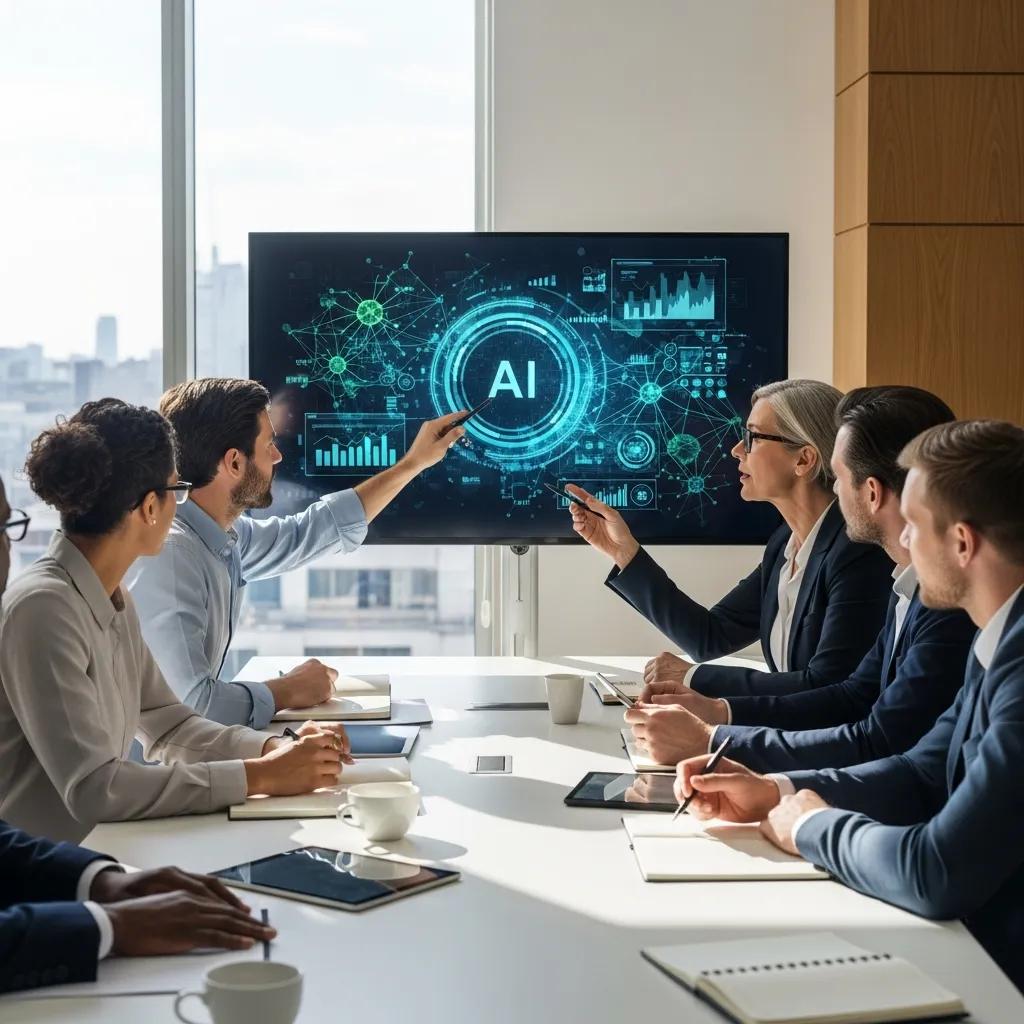These days, everyone’s talking about AI. But generative AI for business? That’s where things get interesting. Small to mid-sized businesses are finding that generative AI is transformative. There are legitimate concerns about the changes and impact. This post helps business leaders discover how generative AI can revolutionize business and how to integrate AI practically and humanely.
Why Generative AI Is Transformative for Business
Think back to the launch of the Netscape web browser or the Apple iPhone. These were pivotal moments.
Generative AI is shaping up to be just as significant. It’s changing how we interact with technology and do business. Artificial intelligence has the potential to be even bigger.
The public marvels at AI writing poems or creating art. The real potential of generative ai systems lies in enterprise applications. Generative AI helps businesses create personalized marketing, boost customer engagement, and refine customer experiences. It can also enhance support services like customer service agents and chatbots (Salesforce).
Conversational AI is projected to cut contact center labor costs by $80 billion by 2026 (Gartner). The financial incentives are clear. This makes it very easy to get started with ai applications in business.
Unlocking Value: Practical Applications of Gen AI for Business
Generative AI offers many possibilities, from streamlining operations to driving innovation. This is not science fiction. Businesses across diverse industries, including support services, see measurable improvements. Let’s explore how AI transforms key business functions, impacting machine learning algorithms.
Revolutionizing Customer Service
AI shines in customer service. AI-powered chatbots handle routine inquiries. This frees human agents to focus on complex issues. Using large language models makes this easy.
This improves efficiency and creates happier customers. Customers get quicker, more relevant help when they need it. Businesses adopting AI based pricing models will improve customer satisfaction (Salesforce). Natural language processing has evolved greatly.
For example, European ridesharing service Bolt deployed a generative AI chatbot and drastically reduced customer service costs. This positive impact has benefited many service operations.
Turbocharging Content Creation
Creating engaging content is challenging. Generative AI helps teams overcome these challenges. It offers various large language models for business leaders.
Tools like Copy.ai, Synthesia, and DALL-E 2 empower teams. They produce blog posts, marketing copy, videos, and images quickly. Automating repetitive tasks frees teams to generate more engaging concepts. Using the proper data store is key for many.
These large language models offer a unique solution to a growing need for efficiency in all business sizes. Even something as complex as creating a privacy policy or generating other kinds of content is simple now.
Accelerating Software Development
Software development is complex and often requires intense concentration. The cost of mistakes can be high. Gen AI assists developers by generating code and suggestions. This speeds up development and reduces bugs. This all helps when learning how organizations respond to generative ai’s potential.
The technology acts like a virtual pair programmer, improving productivity by 66% (source). Integrating generative AI platforms simplifies product lifecycle management. This positive impact carries on through from post-launch. Tools include GitHub Copilot, Tabnine, and Code Snippets AI. You can also leverage generative AI in specific business cases, even small and midsize businesses, via platforms such as Adobe Firefly for product design.
Knowing what problems you most want solved, as well as understanding how a generative AI platform can transform and empower these problems is essential for successful ai implementation.
Supercharging Decision-Making
Making good decisions quickly is crucial for any business. Generative AI helps leaders process large amounts of data. This empowers data-backed decisions.
By sifting through information quickly, these systems unlock new insights. This often leads to breakthroughs. Improving decision-making has a positive impact on all kinds of functions generative AI is currently used for, even manufacturing.
These tools also predict possible outcomes from choices and actions taken. Financial analysts have already begun seeing changes and challenges because of these systems. They have been seen helping significantly when making large enterprise decisions. Using latest generative AI tools can provide financial services leadership insight based on a broader set of data sources.
The Human Element: AI and Employee Well-being
Some fear AI will replace human employees. The opposite is happening. AI augments abilities and increases productivity. Generative AI helps handle repetitive tasks. The state-of-the-art in ai models provides insights to how humans may be able to spend their time at work soon.
This lets teams focus on higher-value work. This boosts engagement, performance, and happiness. As machines improve, AI reduces manual labor. These advancements in artificial intelligence may greatly reduce repetitive manual labor in various kinds of service operations including areas such as customer service operations.
These advancements have shown promise in multiple ways in terms of the potential to affect employee well-being. Generative ai promises to unlock employee creative energy that had been stuck working on monotonous tasks and provide people more opportunity to engage with more enjoyable and higher impact activities at work. Senior partners at large and global firms have spoken openly about exploring enterprise ai strategy to transform work lives of current employees across multiple functions at large companies, particularly knowledge workers.
Getting Started with Gen AI for Business
As of late 2023, Statista reported a growing number of CEOs and CMOs integrating AI. This shows how fast change is upon us. Change can be scary.
It’s understandable to fear new things. Change and challenges force improvement. This is rarely negative for those who adapt intelligently.
The enterprise capabilities of ai technology has created excitement amongst executives in various functions such as operations, manufacturing, engineering, data science, sales and support.
Choose the Right Tools
The generative AI landscape offers many business tools. There are systems for almost every function.
These range from business chatbot platforms like ChatBot and SnatchBot to synthetic data generators like MOSTLY AI and GenRocket. For software developers, there’s GitHub Copilot, Tabnine, and Code Snippets AI. For marketers, consider Jasper AI, Canva, or Runway.
Knowing where to get started in exploring which current generative AI applications and enterprise systems may best assist your needs or in discovering your ai strategy is often the first step towards a successful ai implementation. Several consulting companies like QuantumBlack have invested in deep learning and artificial intelligence, and the senior partner has ai experts to assist clients who are ready to begin the ai transformation process in a human-centered manner.
Start Small, Think Big
Integrating any technology requires a strategy. Select one or two key areas to target first. Aim for quick wins.
Demonstrate AI’s potential. This creates a foundation for scaling future initiatives. This ensures your business can respond to current challenges.
Many enterprises such as McKinsey have shown the positive impact generative AI applications and latest generative ai technologies can have on multiple kinds of enterprise processes including everything from support to operations.
Prioritize Employee Training
Equip your teams with the skills to leverage generative AI. This makes projects more successful. Prioritizing their involvement fosters enthusiasm. Ensure the technology works with existing workflows.
After all, successful businesses leverage people’s skills first. Ai enables transformation in ways that humans may have limitations.
Employee skill gaps can easily be seen across areas like service operations. Senior leaders are thinking differently about where and how people are leveraged to provide high-touch human interactions while automating everything that can be replaced by a latest generative ai system. These transformations also require that business functions adapt. Executives may need to think differently about the organizational structure. New kinds of enterprise ai experts are required as firms transform themselves and seek new ways to improve efficiency, service, and customer engagement while cutting costs.
FAQs about gen ai for business
How is generative AI used in business?
Generative AI transforms business functions. It’s used in customer service with AI chatbots and content creation through automation. It speeds up software development with code generation and enhances decision-making through data processing.
Can you use OpenAI for business?
OpenAI offers models like GPT-4 and DALL-E. These integrate into business workflows for customer interactions, text and image generation, and software development. For other uses like summarizing information, consider Google Gemini or Quillbot. Large organizations may build their own platforms. Small businesses can use readily available platforms.
How does GenAI affect businesses?
GenAI significantly impacts businesses. It automates tasks, boosts efficiency, and personalizes customer experiences. It also shifts needed skills. Neural networks in artificial intelligence continue evolving. Some older skillsets become obsolete while demand for new ones grows. Ai experts predict broader impact for generative models soon, even in HR, across a wider range of organizations as generative ai enables functions not possible before.
How can AI be used in business?
AI transforms operations through diverse uses. It benefits project management (Dart, Notion AI) and cybersecurity (Microsoft Security Copilot). Generative ai systems provide significant potential advantages, but also create new challenges.
Realizing the Transformative Potential of Generative AI
Generative AI is transforming business. It generates content, answers queries, and even creates privacy policies. These changes go beyond simple novelty. Businesses discover new use cases every day. This ai technology is evolving how businesses make choices and transform data scientists work with data in their day-to-day. Generative ai systems are empowering these experts with new opportunities to improve operations, sales and marketing as well as research and development.
Generative AI enhances human ingenuity. This offers immense potential for profit and people when integrated thoughtfully. Focus on people first. Understand how technology enhances human work.
Leaders prioritizing people see benefits and cost savings using generative AI. It’s transforming areas like HR, supply chain, and manufacturing. The key is knowing your business problems. Find the generative AI systems to empower your needs. How a business leverages artificial intelligence depends on that businesses overall ai strategy and desired outcomes. Natural language in large language models and new enterprise tools continues transforming at a rapid pace. There are numerous platforms, both free and paid. Generative AI’s possibilities feel endless.






